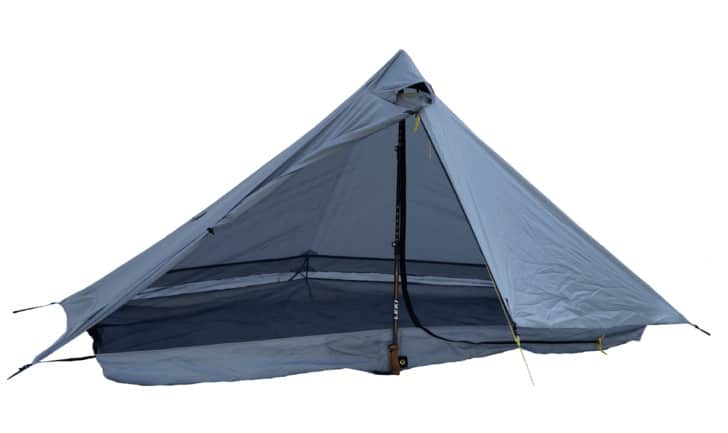Introduction
The Six Moon Designs Lunar Solo is a one-person, single-wall, three-season, trekking pole supported shelter. It weighs 26 oz (737 g), has an MSRP of $230, and is reasonably considered an entry-level shelter for backpackers on a budget who’d like to experiment with a non-traditional, lightweight shelter. This Six Moon Designs Lunar Solo review discusses key performance metrics, including weather resistance, livability, and condensation resistance.

If you browse the likes of Reddit and YouTube, you’ll note that the Six Moon Designs Lunar Solo is a somewhat popular shelter in the lightweight hiking community. Its relatively light weight and modest price makes it an appealing option for thru-hikers or backpackers looking to move away from traditional double-wall tents and drop some weight from their pack without spending a lot of money.
Its design attempts to check all the boxes backpackers are looking for: ventilation, bug protection, shelter from the elements, minimal weight, and livability. Its silicone-coated polyester canopy fabric requires seam sealing to be completely waterproof, which is a service available from Six Moon Designs for an additional fee of $30.
Receiving accolades from Backpacker Magazine, The Trek, ISPO, and Garage Grown Gear, this is a shelter that has been on the market for several years, seen various upgrades during that time, and is one of the flagship pieces from Six Moon Designs. This review describes the most recent version of the shelter (a model that was shipped to us by Six Moon Designs in July 2019).
Features & Specifications
Features
- Single-entry (side)
- Vestibule
- Asymmetrical pyramid shape
- Apex vent
- Trekking pole supported (or optional straight pole)
- Interior pockets for organization
- Large mesh door for ventilation
- Floor design minimizes tension and helps prevent punctures
- Spacious interior
- Made in China
Specifications
- Total weight, excluding stakes or optional pole: 26 oz claimed (737 g), 26.2 oz measured (742 g)
- Material: Silicone coated polyester – 20D canopy and 40D floor
- Packed size: 11 in x 4.5 in (28 cm x 11 cm)
- Floor area: 26.25 sq ft (2.4 sq m)
- Vestibule: 8.5 sq ft (0.8 sq m)
- Apex: 48 in (122 cm)
- Stakes needed: 6 (min), 8 (max)
- Stakes included: 0 (I used six MSR Groundhogs and two Nemo Airpins for the optional guylines during testing) – here’s why a lightweight Y-stake like the MSR Groundhog and Groundhog Mini offers the best tent stake holding power for its weight and size)
- An optional 49 in (124 cm) pole is available in carbon fiber (1.8 oz / 51 g) or aluminum (3.2 oz / 90 g)
Review Context
I’ve primarily used an MSR Hubba for three-season backpacking and occasionally used a tarp or tarp with a bivy sack for fast-and-light trips or trips where the weather forecast was favorable for a minimalist shelter. I’ve used a Black Diamond Firstlight for winter trips and ski touring. This test was my first experience with a trekking pole supported shelter and a pyramidal design. My experience with single-wall shelters was limited to the Firstlight, which I used in temperatures below freezing, with snow being the only precipitation. At an affordable $230 and appealingly low weight of 26 oz (740 g), I was eager to see how this shelter performed during summer conditions in the Northern Rockies.

My first excursion with the Six Moon Designs Lunar Solo, a five-night trip in Glacier National Park, provided perfect conditions to test its wind and weather resistance. Three of the five nights featured rain showers, including some heavy downpours that lasted nearly the entire night. Two separate afternoon thunderstorms forced me inside to seek shelter and wait for the storms to pass before emerging during breaks in the storms to cook dinner. On one particularly stormy evening, I was in the tent from approximately 3 p.m. to 5:30 p.m., then from 6:15 p.m. until 8 a.m. the next morning. I was able to spend a lot of time evaluating the livability and spaciousness of the tent on that trip.
Additional testing included a short trip to Yellowstone National Park, a trip in the subalpine high-country of the Bitterroot National Forest, and a three-day trek in the Pioneer Mountains of Montana.
In the Bitterroot National Forest, I experienced pitching the tent in less-than-ideal conditions due to rocky ground. The Pioneer Mountains had near-constant evening and nighttime winds in the 10-15 mph range (16-24 kph) with gusts up to 25 mph (40 kph).
In addition to my experience as described above, some of Ryan Jordan’s (Backpacking Light’s Publisher) experiences are described herein as well, since Ryan used the shelter in more inclement environments (higher winds and snow).
Performance Assessment
I assessed the performance of the Six Moon Designs Lunar Solo by focusing on the following categories:
- Wind and weather resistance
- Ease of use
- Condensation management
- Durability
- Livability
- Compressibility and weight
Wind and Weather Resistance
Member Exclusive
A Premium or Unlimited Membership* is required to view the rest of this article.
* A Basic Membership is required to view Member Q&A events




Home › Forums › Six Moon Designs Lunar Solo Review